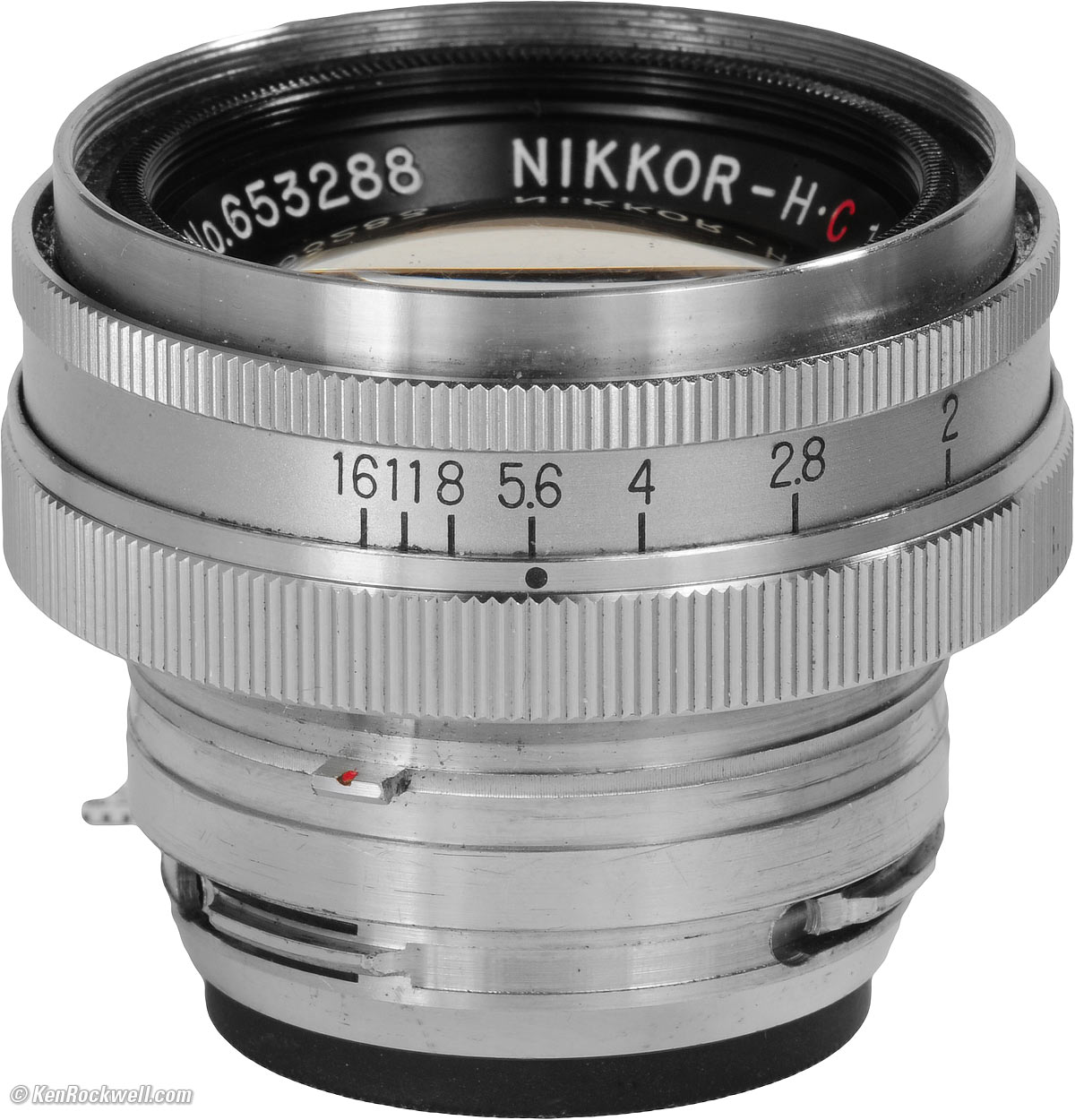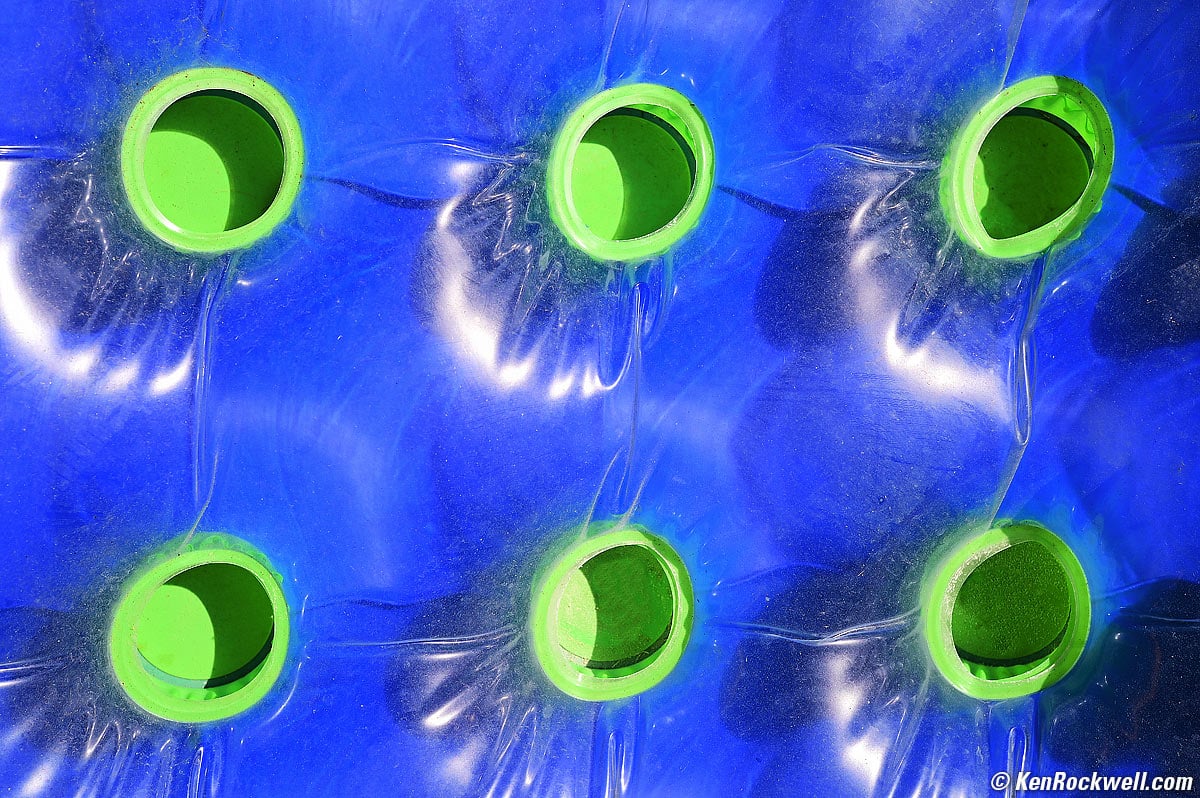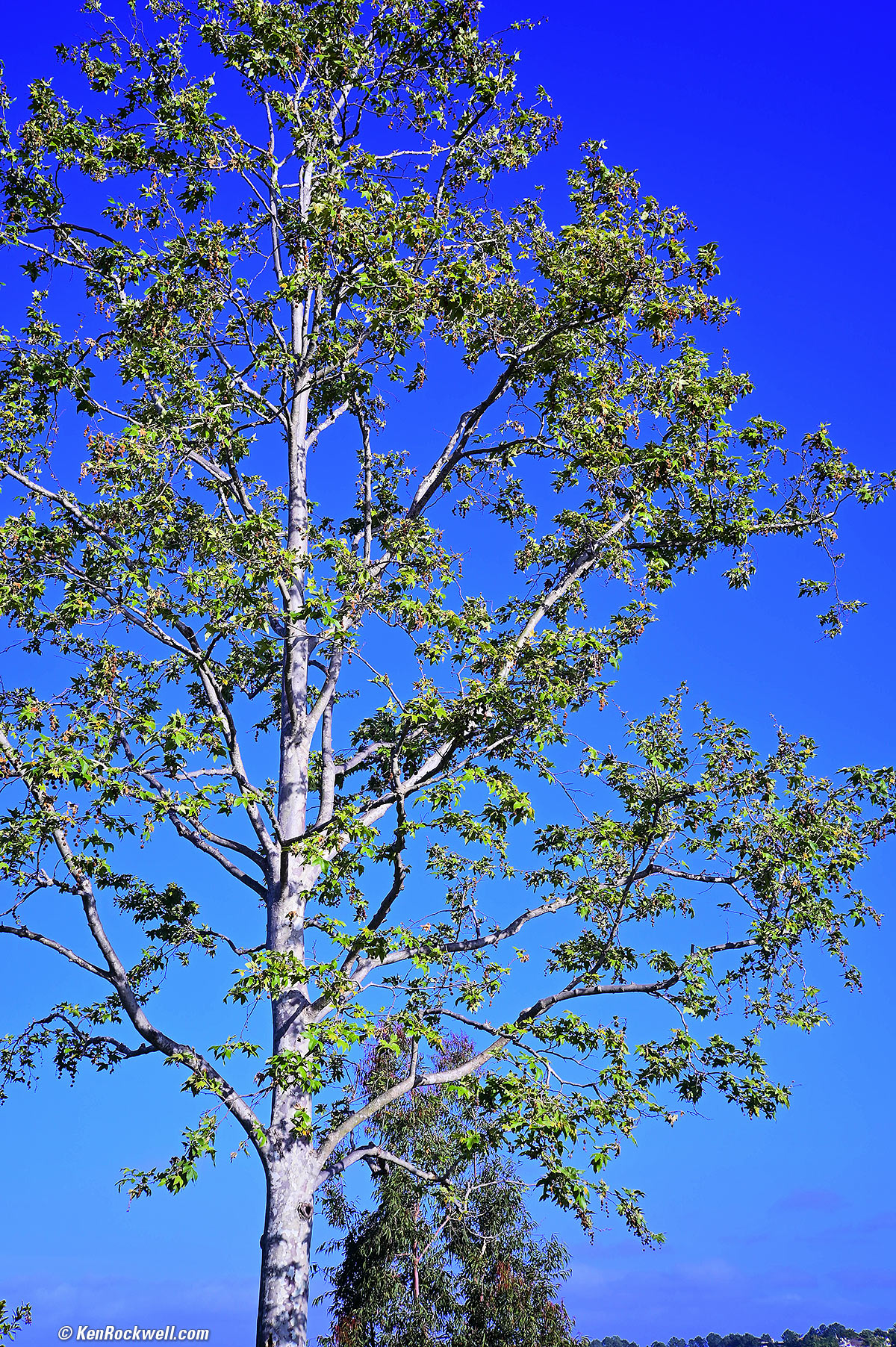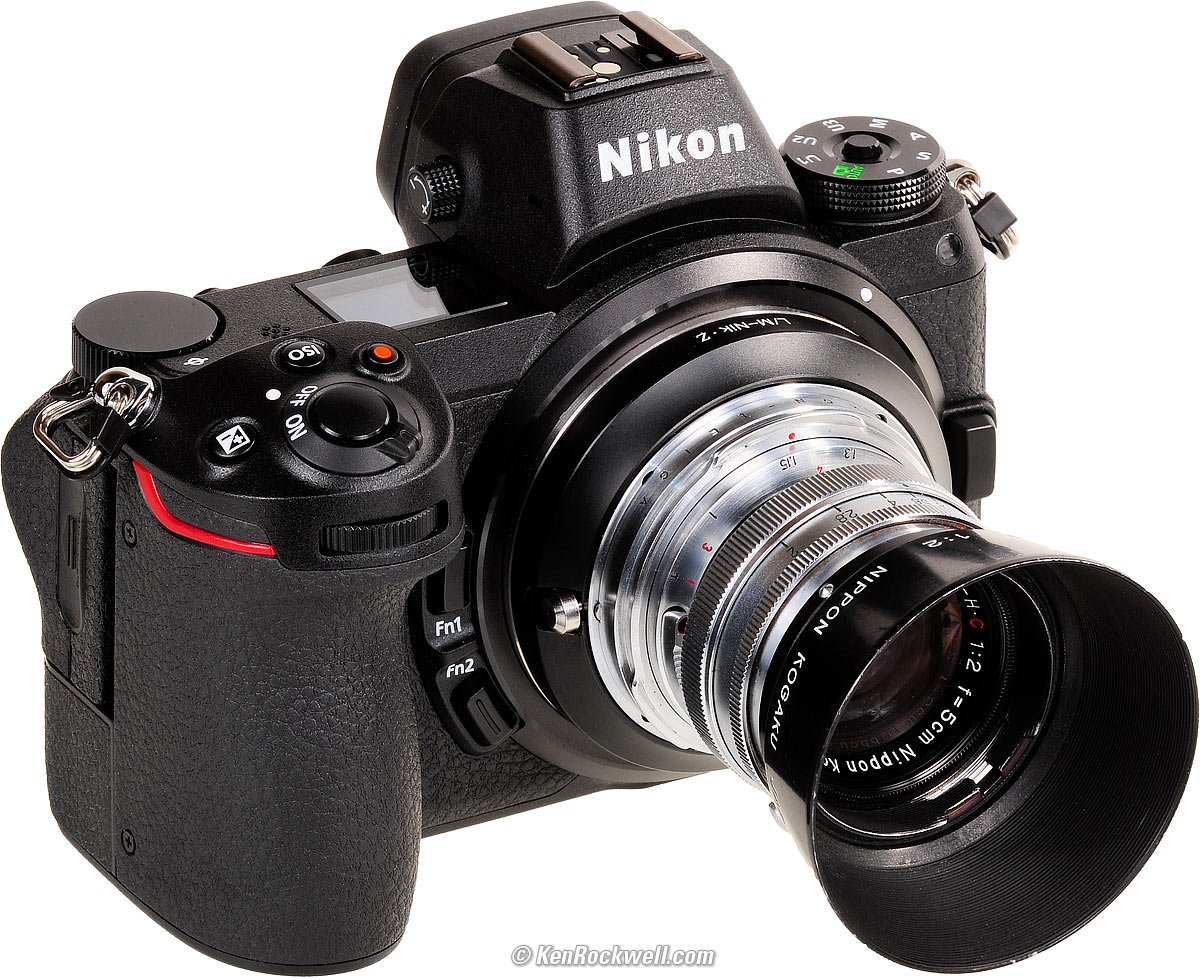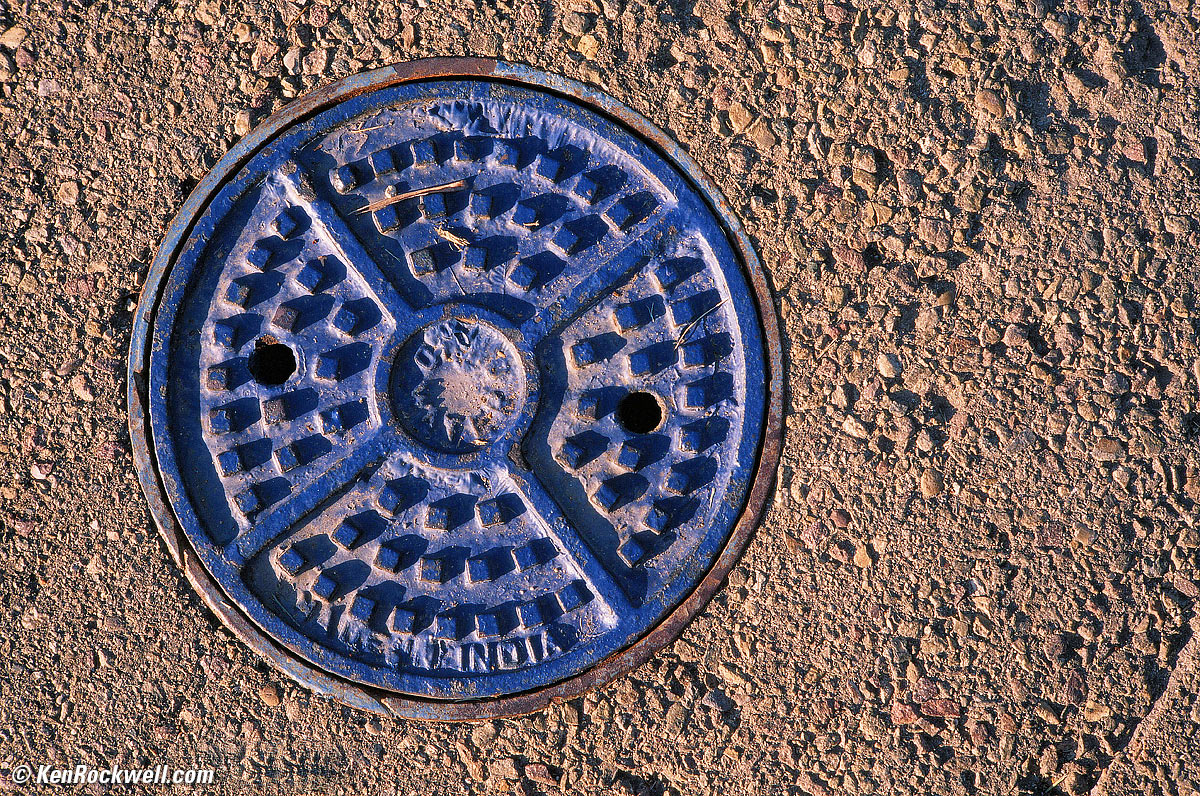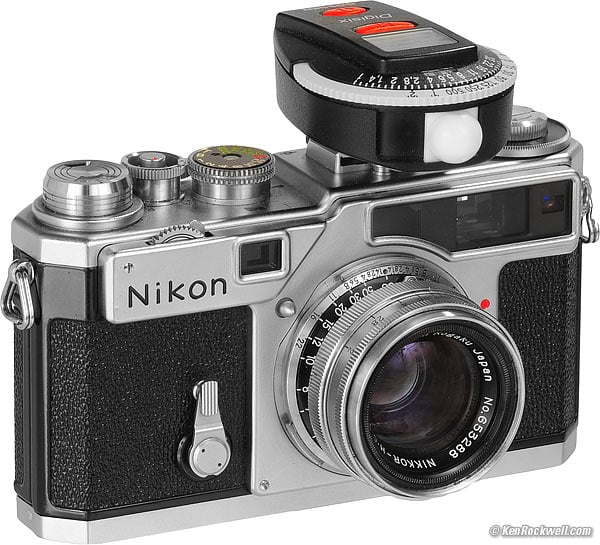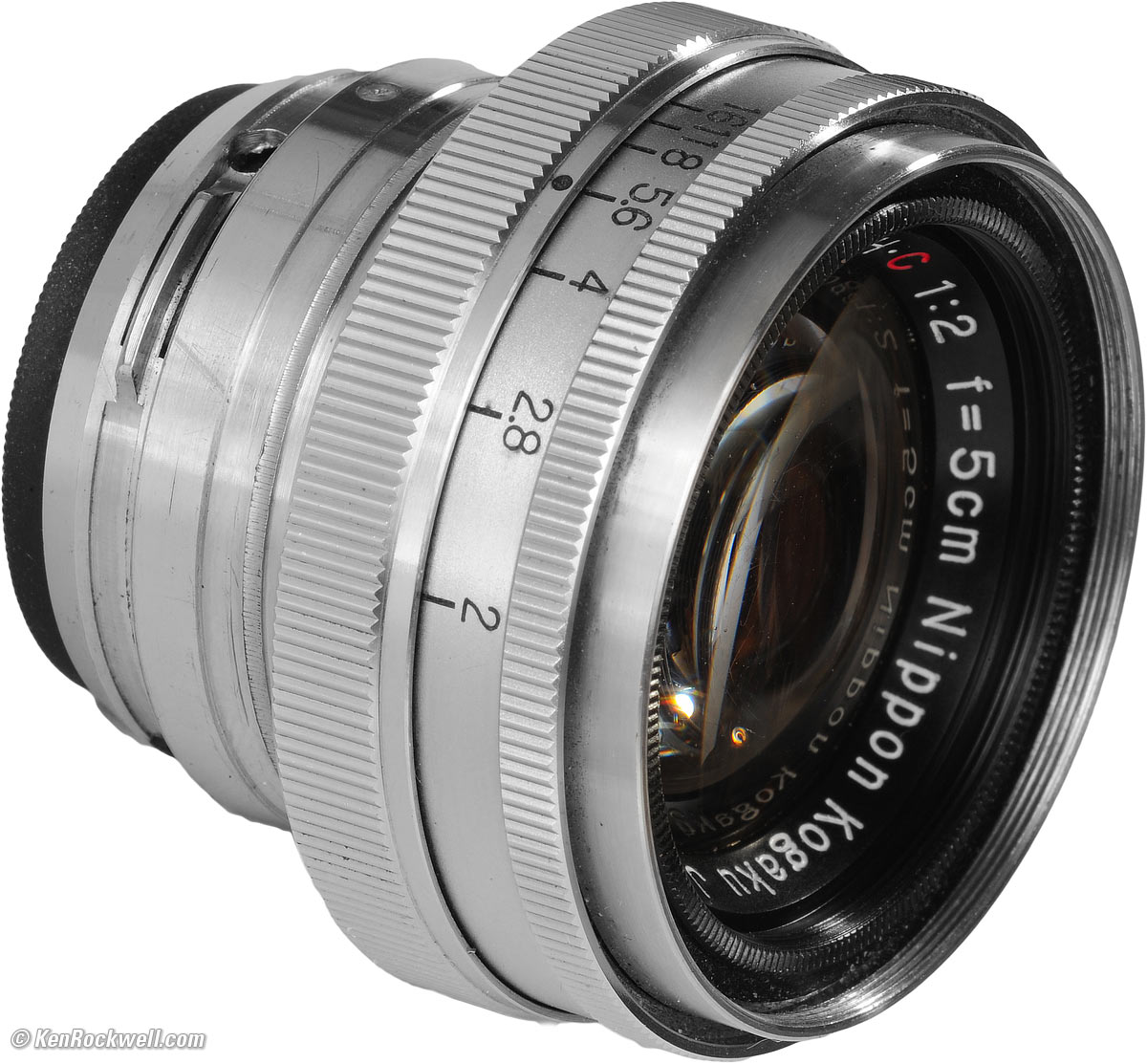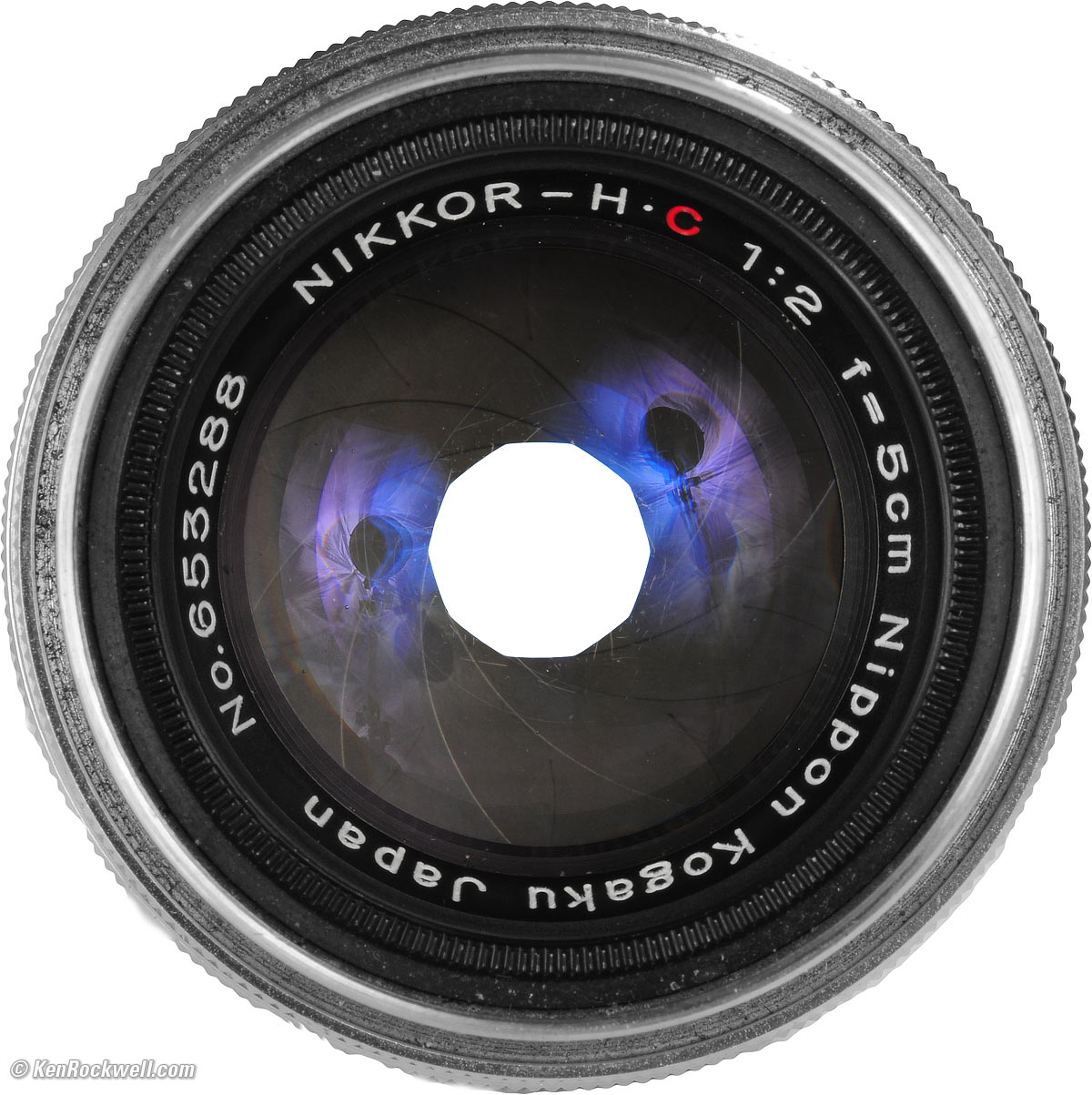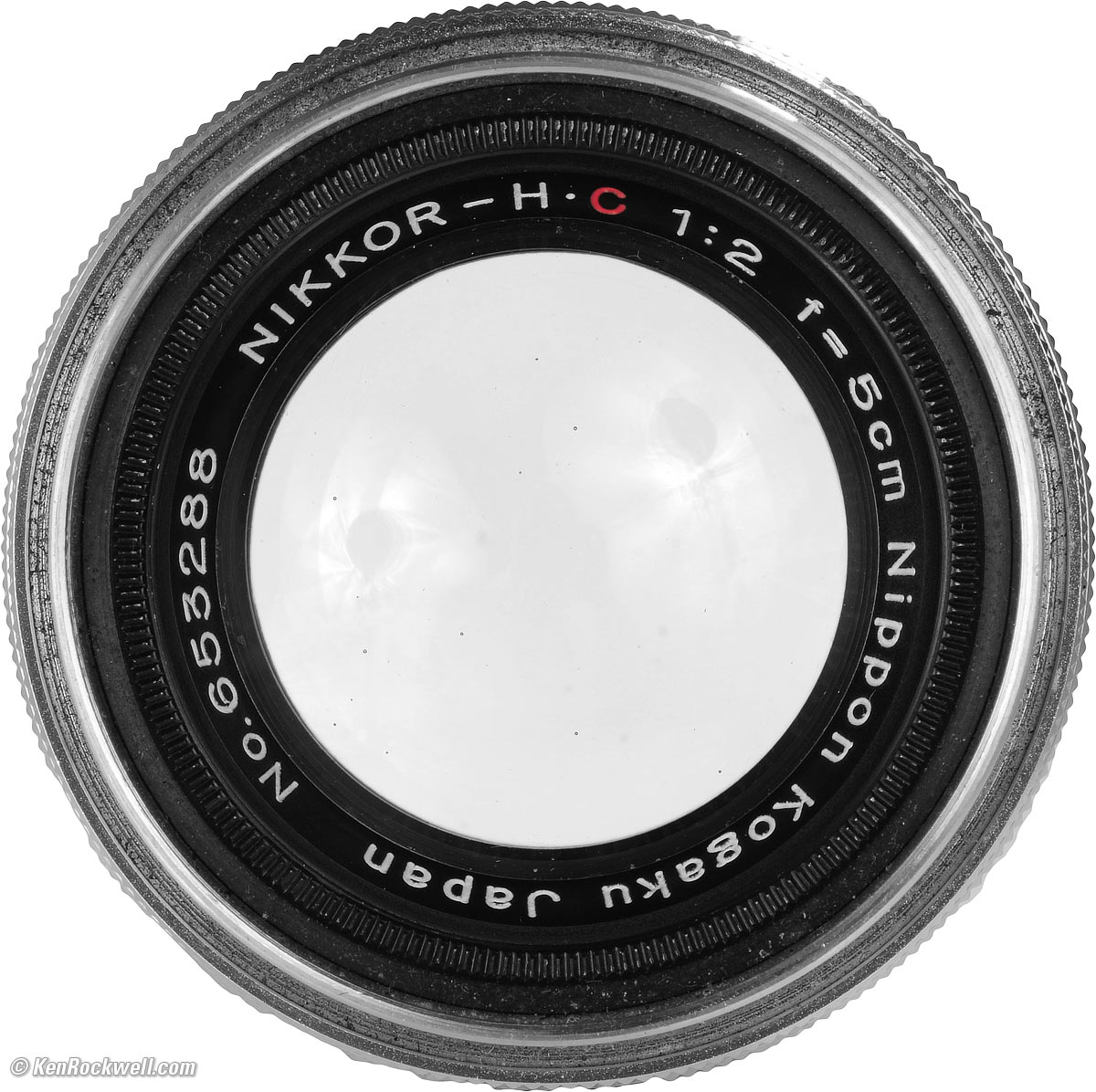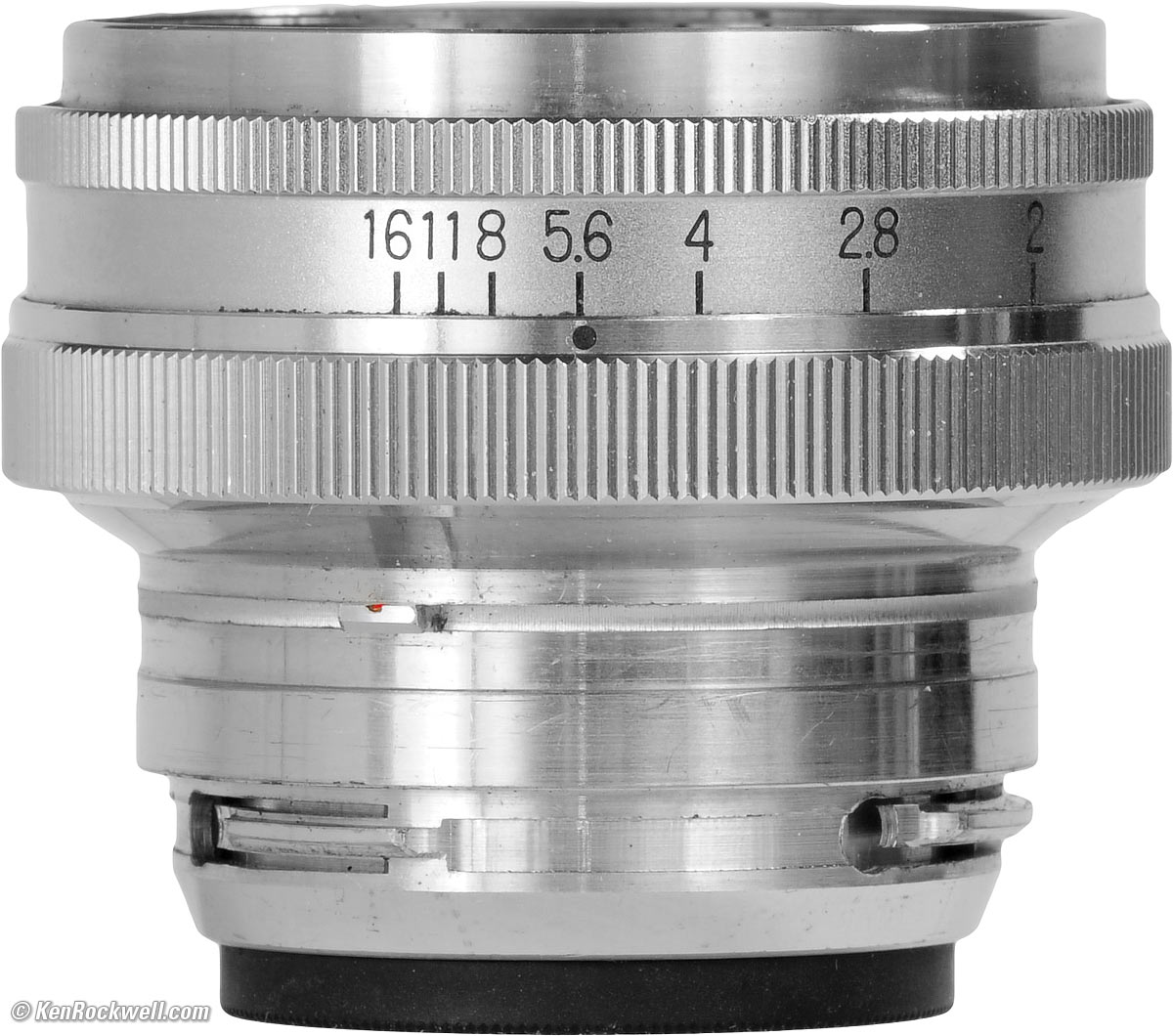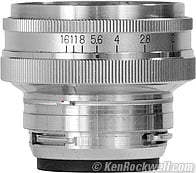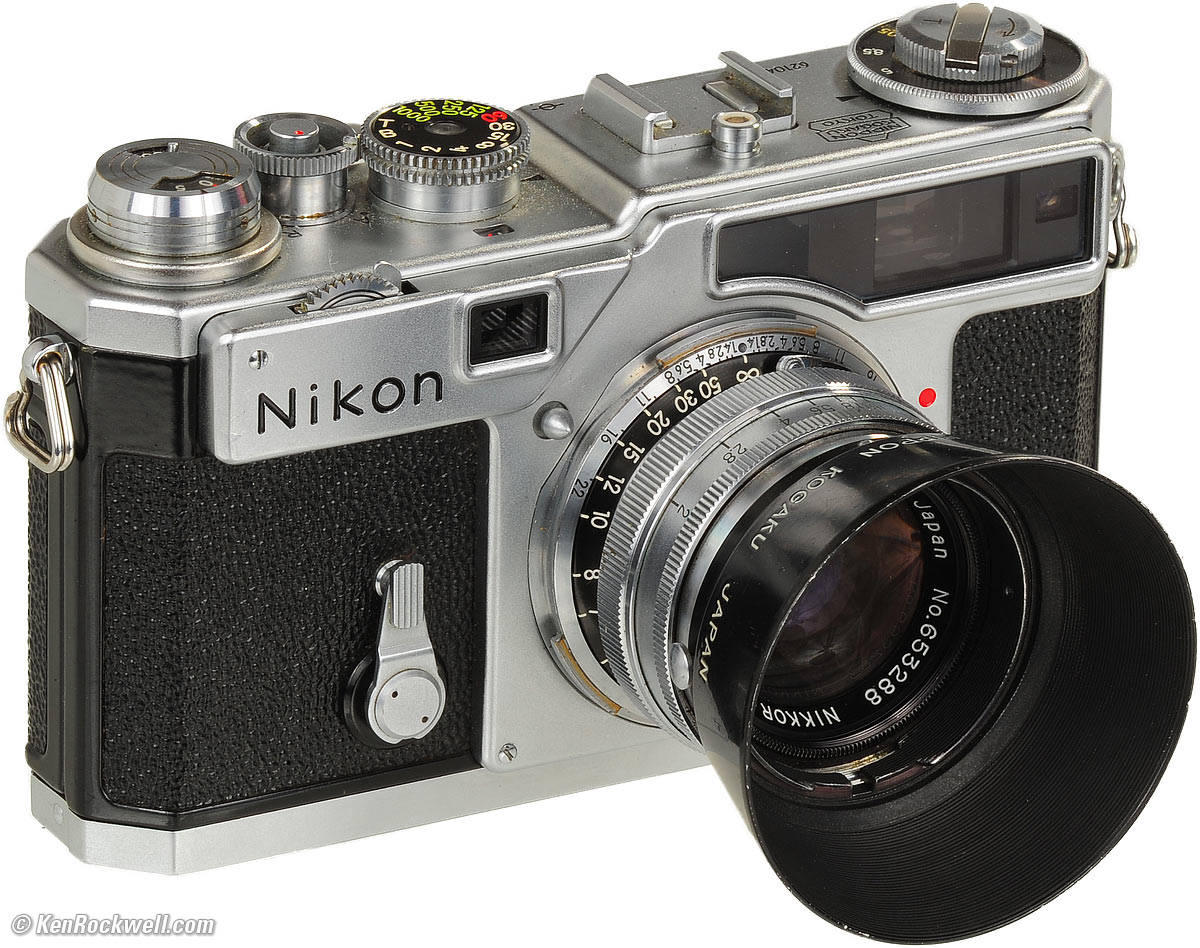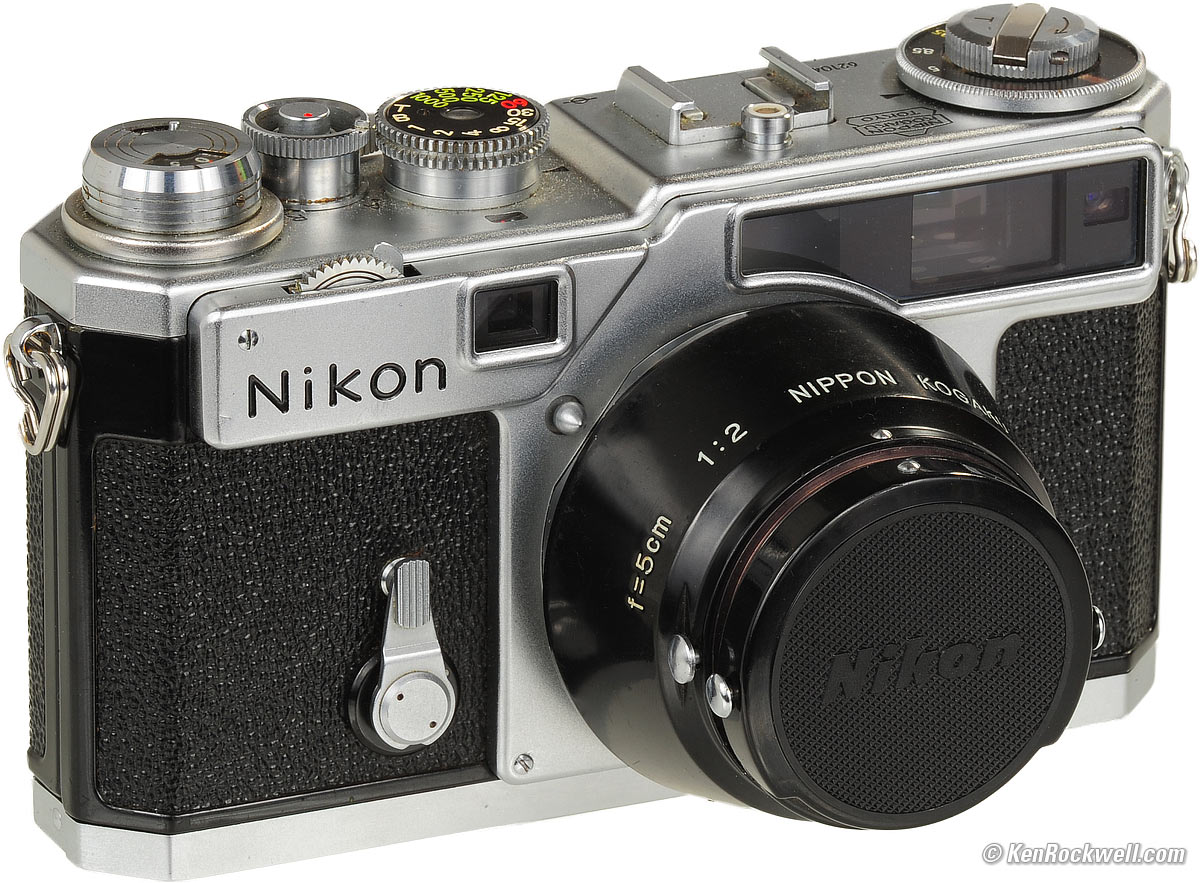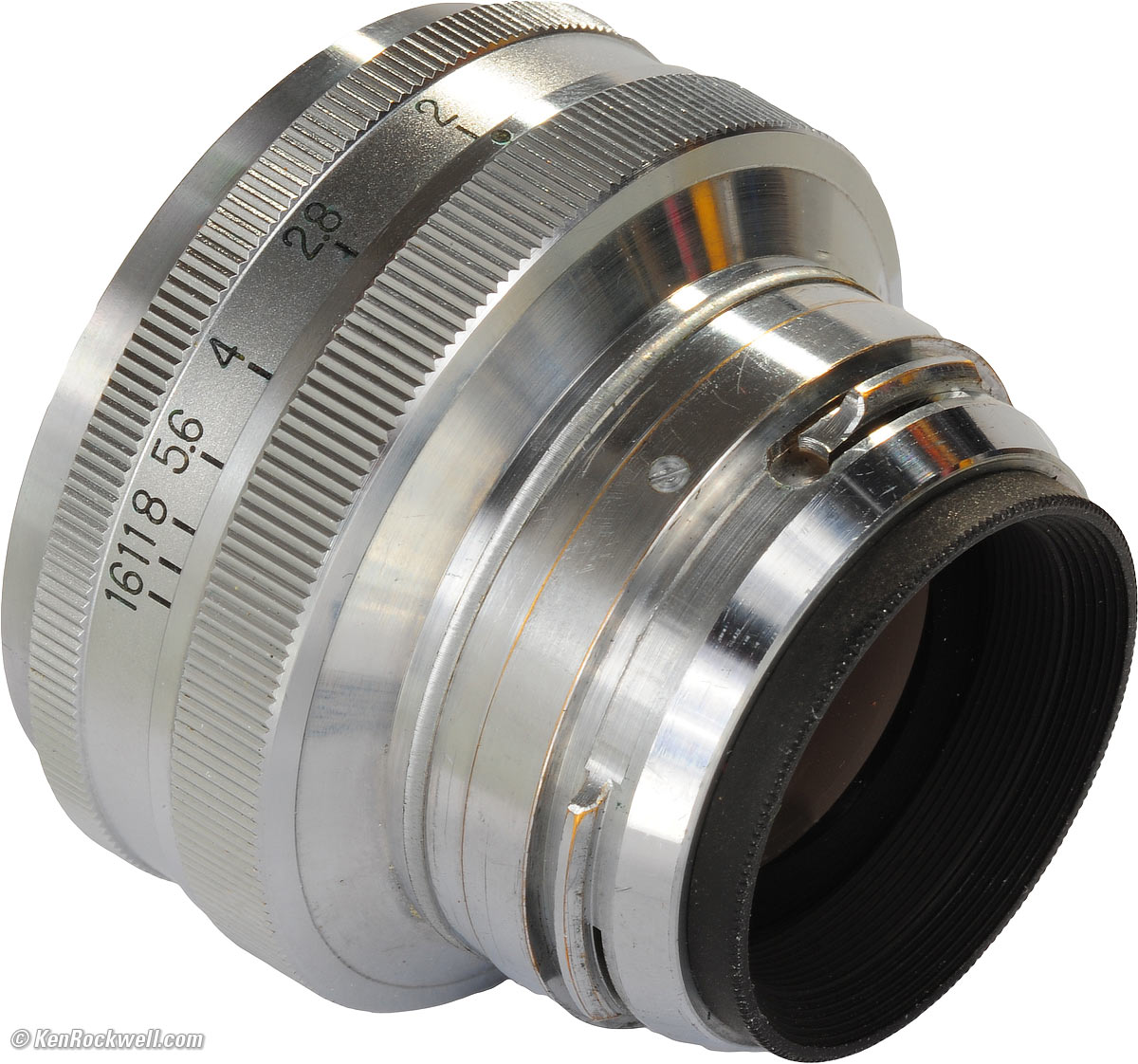Nikon 5cm (50mm) f/2
NIKKOR-H•C (1946-1962)
Sample Images Introduction Specifications
Performance Compared Recommendations
Nikon 5cm (50mm) f/2 (40.5mm filters, 4.7 oz./134g, about $200 used if you know How to Win at eBay). enlarge. This free website's biggest source of support is when you use that or any of these links when you get anything. Thanks! Ken.
April 2019 Nikon Rangefinder System Modern Nikon System All Reviews
Why Fixed Lenses Take Better Pictures
Using Rangefinder Lenses on Nikon Z Mirrorless Cameras
Sample Images
Top Sample Images Intro Specifications
Performance Compared Recommendations
Blue and Green Pool Float, 09 April 2019, 5:27 PM. Nikon Z6, 5cm (50mm) f/2 NIKKOR-H•C on adapters, f/8 at 1/320 at Auto ISO 100, Perfectly Clear. bigger, full-resolution or camera-original © file.
Not bad for an old weathered pool float shot with an over-70-year-old lens. This lens was Nikon's first lens for its first camera made in occupied Japan a year after World War Two. The Z6 lets us adapt this and just about any lens to it for great results, complete with Image Stabilization!
Tree, 09 April 2019, 5:27 PM. Nikon Z6, 1946 5cm (50mm) f/2 NIKKOR-H•C on adapters, f/8 at 1/250 at Auto ISO 100, Perfectly Clear. bigger, full-resolution or camera-original © file.
Nikon Z6 and 1946 5cm (50mm) f/2 NIKKOR-H•C used to shoot the two photos above. The lens is on a Nikon S rangefinder to LEICA M adapter which is on a second LEICA M to Nikon Z adapter. These adapters all come from eBay. bigger.
Manhole Cover, 06 September 2010. bigger or high-resolution file (5MB) from Fuji Velvia scan.
Introduction
|
I buy only from these approved sources. I can't vouch for ads below. |
Top Sample Images Introduction Specifications
Performance Compared Recommendations
Compatibility History Production Pricing
The Nikon 5cm (50mm) f/2 was a very popular lens for Nikon's S series of rangefinder cameras, of which the Nikon SP is the best and most famous.
I'm very impressed at the 50mm f/2's performance, especially considering that it was first introduced in 1946!
Used properly, it's sharp and contrasty even wide-open.
I got my 50mm f/2 NIKKOR-H•C at this link to it at eBay, but these are so old it may take some waiting to find one in usable condition (see How to Win at eBay).
5cm f/2 on a Nikon SP with Gossen Digisix. enlarge.
The Nikon S-mount 5cm f/2 works on all Nikon rangefinder cameras.
The Nikon S-mount is completely incompatible with any of Nikon's F-mount SLR or DSLR cameras or lenses.
It's easy to use these on Nikon's Z Mirrorless Cameras with the right adapters.
Introduced in 1946 along with Nikon's first camera ever, the Nikon One, this 50mm f/2 saw several cosmetic variations, but used the same coated optics until Nikon forgot about the rangefinder system in 1962.
Nikon made about 100,000 of these 5cm (50mm) f/2 lenses.
Like most Nikon lenses, the same optics were sold in many shiny or matte chrome or black enamel cosmetic variations.
Catalog Price* |
Selling Price* |
|
1951 |
$890 |
|
1952 |
$1,025 |
|
1957 |
$825 |
|
2010 |
$150-$300 used |
* Corrected for inflation in 2010.
Nikon 5cm (50mm) f/2 . enlarge.
Specifications
Top Sample Images Introduction Specifications
Performance Compared Recommendations
I got my 50mm f/2 NIKKOR-H•C at this link to it at eBay, but these are so old it may take some waiting to find one in usable condition (see How to Win at eBay).
Name
Nikon calls this the NIKKOR-H•C 5cm f/2.
NIKKOR is Nikon's trademark for its lenses.
H stands for "hex," meaning this lens has six elements.
C means coated, which was a competitive advantage for Nikon in the 1940s, but as all other brands of lenses were coated by 1957, Nikon dropped the C.
5cm means 50mm.
Optics top

Nikon 5cm (50mm) f/2.
6 elements in 3 groups.
All are single-coated.
No, this diagram isn't supposed to be an asymmetrical aspheric design; it's how I drew the thing on a napkin while having sake out in Japan a little while ago.
Diaphragm top
Nikon 5cm (50mm) f/2 at f/5.6. enlarge.
10 straight blades.
Stops down to f/16.
Aperture Ring top
Yes.
Metal.
Full-stop clicks, uneven spacing.
Close Focus (set on camera) top
3 feet.
0.9 meters.
Hard Infinity Focus Stop? top
Yes, on camera.
This is great for astronomy; just turn to the stop and you have fixed laboratory-perfect focus all night.
Focus Scale top
Yes, on camera.
Depth-of-Field Scale top
Yes, on camera.
Infra-Red Focus Index top
Sort of: Nikon says to use the f/2.8 index on the camera's depth-of-field scale.
Other Nikon 50mm lenses need different indices, so Nikon couldn't make one mark that would apply to all of their f/2, f/1.4 and f/1.1 lenses.
Filter Thread top
40.5 x 0.5 mm, chromed brass.
Rotates with focus.
0.5mm is a finer thread pitch than larger filters. Luckily, unlike with 43mm filters, today's 40.5mm filters still use this finer pitch, so any Hoya, B+W or Tiffen filter today should work perfectly.
Hood top
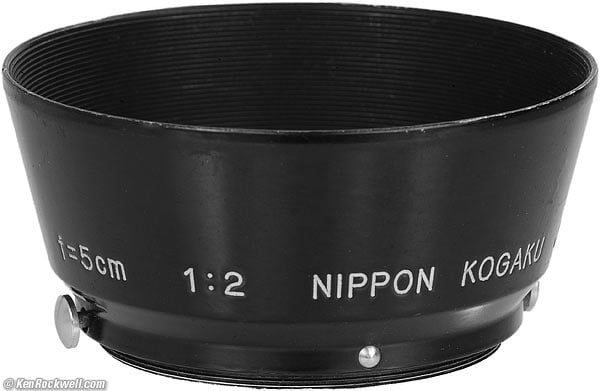
Nikon 5cm f/2 hood.
The all-metal, enameled conical hood attaches with Nikon's standard split spring-loaded, 40.5mm attachment.
The markings are engraved and filled with paint.
See more under Hood, under performance.
Size top
1.567" (39.80mm) overall length by 1.850" (46.99mm) diameter, measured.
Weight top
4.715 oz. (133.7g), measured.
Different cosmetic versions may differ.
Introduced top
Fall 1946.
Made in top
Japan.
Performance
Top Sample Images Introduction Specifications
Performance Compared Recommendations
Overall Focus Bokeh Bubbles Color Diaphragm Calibration
Distortion Ergonomics Falloff Filters Finder Blockage Hood
Color Fringes Mechanics Sharpness Spherochromatism Sunstars
I got my 50mm f/2 NIKKOR-H•C at this link to it at eBay, but these are so old it may take some waiting to find one in usable condition (see How to Win at eBay).
Overall performance top
The 5cm (50mm) f/2 is much better than I expected for a lens designed in 1946!
It's softer at f/2, but cleans right up by f/2.8. It's sharper at most apertures than the 5cm f/1.4, which is as expected in this era. Back in the 1950s, people knew that faster lenses sacrificed optical quality for speed, and thus slower lenses were sharper.
Focus performance top
On a Nikon SP, I found focus to be right-on at all distances at f/2.
Bokeh performance top
Bokeh, the character of out of focus backgrounds, not simply how far out of focus they are, is mediocre.
It's better than the funky organic bokeh of the 5cm f/1.4, but still tends to be more distracting than neutral.
Blur circles have soft edges, but the edges are slightly brighter than their centers.
Bubbles back to performance back to top
Specks of internal dust? enlarge.
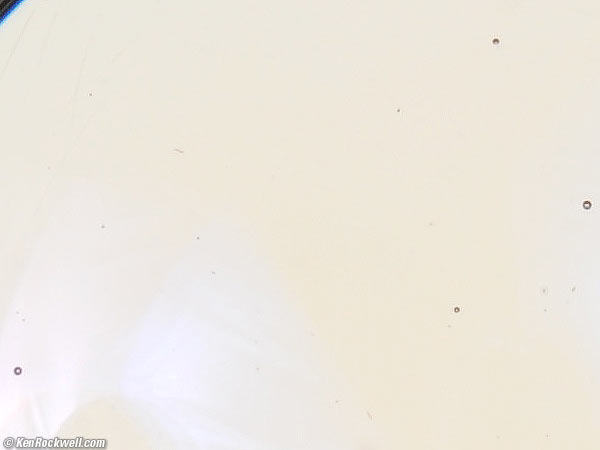
Close-up of upper left: tiny bubbles!
Back in the good old days, making glass was even more of a pain than it is today.
The bubbles are leftover from when the sand and other materials were melted and stirred to make glass. Today we heat the mix electrically (liquid glass is a good enough conductor) and under a vacuum to remove the air bubbles.
Some special kinds of optical glass used back then were especially susceptible to these microscopic bubbles. This is why instruction sheets of the era always said something like "tiny bubbles are a sign of high-quality glass and are in no way a defect or will they affect picture quality," to try to prevent weenies from returning perfectly good lenses.
Bubbled lenses are especially prized by collectors. This lens still has original 1950s air in it, forever!
These bubbles are invisible to the eye. To the eye, these are completely invisible unless magnified, and even when magnified, usually just look like dust. These are visible as bubbles only under high magnification as shown above.
Color Rendition performance top
The color rendition of this Nikon 50mm f/2 matches my other Nikon S-mount lenses, except for the 35mm f/1.8, which is much warmer than the other lenses.
Diaphragm Calibration performance top
My slides matched perfectly as I shot at each stop from f/2 to f/16; bravo!
Distortion performance top
The Nikon 5cm (50mm) f/2 has minor to moderate pincushion distortion. You won't see it unless you are deliberately looking for it.
It can be corrected by plugging these figures into Photoshop CS2's lens distortion filter. These aren't facts or specifications, they are the results of my research that requires hours of photography and calculations on the resulting data.
Distance |
Correction Factor |
10' (3m) |
-1.5 |
3' (1m) |
-1.2 |
© 2010 KenRockwell.com. All rights reserved.
Ergonomics performance top
Nikon 5cm (50mm) f/2. enlarge.
Nikon 5cm (50mm) f/2, actual size at 106 DPI. enlarge.
The Nikon 5cm (50mm) f/2's ergonomics are a little better than the f/1.4 because there is a little more spacing between the smaller apertures.
Except for setting the aperture, this lens is about as passive as a golf ball; it doesn't even have its own focus mechanism! It's simply an optical tube that mounts into the Nikon rangefinder camera bodies.
The aperture ring of this particular cosmetic variation is matte chrome, which is easy to read in any light, however the black index dot is on bright chrome, and therefore usually invisible in any light.
Falloff (darkened corners) performance top
Falloff is moderate at f/2, almost invisible at f/2.8, and gone by f/4.
Filters, Use with performance top
There is no problem with vignetting.
Finder Blockage performance top
There is no finder blockage at any distance, unless you use a hood.
If you use the hood, there is a good deal of blockage:
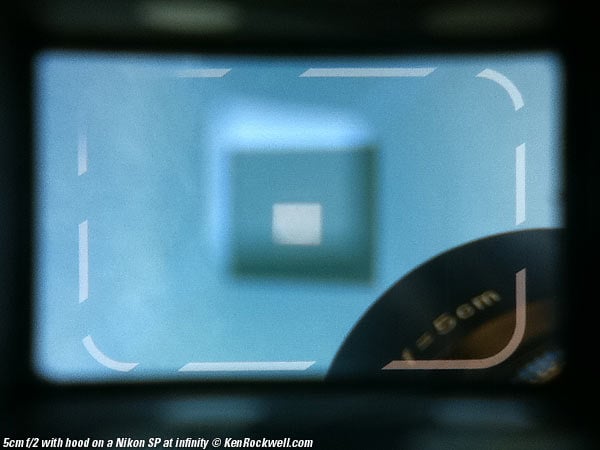
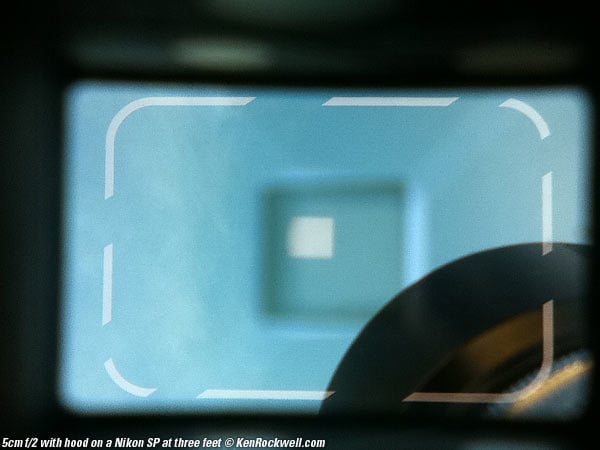
Hood performance top
As a conical hood, it is designed well so that it offers the best shielding it can for its size without blocking any of the on-film image, however it blocks a lot of the viewfinder.
A proper reverse conical design, like the LEICA 12 585, would have given the same protection from flare without blocking the finder as does this NIKKOR hood. (The two hoods are not interchangeable.) Oh well, this is one of the many reasons that LEICA outsold Nikon by ten times in the 1950s, and why Nikon rangefinders died a fast death, and LEICA lives strong to this day.
Nikon 5cm (50mm) f/2, with hood deployed, on a Nikon SP. enlarge.
The all-metal hood attaches, removes and reverses by pushing the two spring-loaded metal tits. These compress the split, threaded spring ring that attached to the 40.5 x 0.5mm threads of the 50/2 lens.
The threaded split ring has threads on both sides, so the hood also mounts in reverse for stowage.
When reversed, the standard 40.5mm cap will attach to the front of the reversed hood, improving survivability when stowed.
Nikon 5cm (50mm) f/2, with hood stowed, on a Nikon SP. enlarge.
Lateral Color Fringes performance top
I can't see any on Velvia 50, either at 22x magnification optically, or scanned at 3,600 DPI.
Mechanics performance top
Nikon 5cm (50mm) f/2 . enlarge.
This Nikon NIKKOR 5cm (50mm) f/2 is an optical tube with a diaphragm. It doesn't even have focus helicoids.
Barrel Exterior
Chromed brass.
Filter Threads
Chromed brass.
Internals
All metal.
Aperture Ring
Machined chromed brass, or black-enameled (depending on cosmetic variation).
Engraved markings filled with paint.
Mount
Chromed brass.
Markings
Engraved and filled with paint.
Identity and Serial Number
On front of lens inside filter ring, engraved into the metal and filled with paint.
Ass-Gasket (dust seal at mount)
No.
Noises When Shaken
Almost silent clicking from the diaphragm blades.
Made in
Japan.
Sharpness performance top
Warning 1: Image sharpness depends more on you than your lens.
Warning 2: Lens sharpness doesn't mean much to good photographers.
Manhole Cover, 06 September 2010. f/6.3 at 1/60 at 3.6 feet. bigger or 3600 DPI scan.
This is sharp, and this is hand-held at a low shutter speed at close distance!
The 5cm (50mm) f/2 is better than expected for a lens that was designed in 1946.
For normal subjects with normal contrast, this Nikon 50mm f/2 is sharp and contrasty even at f/2 in the center. If you don't have a lot of subject contrast, the slight veiling at f/2 is invisible, and this lens gives a very sharp image throughout most of the image field, even at f/2.
It's actually very sharp at anything other than f/2. My observations below are looking at film at 3,600 DPI (36x); for actual photography, f/2 is a tiny bit hazy if you have a contrasty subject, and this lens is super-sharp from f/2.8 on.
At f/2
Contrast and sharpness are down a bit, with a light veiling flare from spherical aberration.
It's still more than sufficient for use in the low light under which you'd shoot at f/2.
At f/2.8
All the veiling flare is gone by f/2.8.
The center is super-sharp, while the sides better than f/2, but still blurrier than the center.
At f/4
The sides are much better than at f/2.8, but still slightly blurry compared to the ultra-sharp center.
At f/5.6
The sides are just about perfect.
At f/8
Everything is super-sharp at f/8. f/8 is optimum, but only because the corners are ever so slightly less sharp at f/5.6 and f/4.
Spherochromatism performance top
I saw no spherochromatism, meaning that out-of-focus highlights don't take on color fringes.
Sunstars performance top
With its 10-bladed diaphragm, the 5cm (50mm) f/2 should make 10 -pointed sunstars on bright points of light.
Compared
Top Sample Images Introduction Specifications
Performance Compared Recommendations
I got my 50mm f/2 NIKKOR-H•C at this link to it at eBay, but these are so old it may take some waiting to find one in usable condition (see How to Win at eBay).
I prefer the sharpness of this slower f/2 lens to the 5cm f/1.4.
Distortion and falloff at the same aperture seem to be the very similar, with possibly less falloff at smaller apertures in this f/2 lens.
Forget comparing it to a 1956-1968 LEICA SUMMICRON 50mm f/2, which is far superior optically and mechanically. It's both much sharper and has far less distortion. This is also why these SUMMICRONS sell for about five times as much in 2010.
The original 1953-1960 LEICA SUMMICRON 50mm f/2 was probably about as good; I haven't shot them off directly against each other.
Recommendations
Top Sample Images Introduction Specifications
Performance Compared Recommendations
I got my 50mm f/2 NIKKOR-H•C at this link to it at eBay, but these are so old it may take some waiting to find one in usable condition (see How to Win at eBay).
This is my favorite period 50mm lens for the Nikon rangefinders. I find it sharper than the equally popular period 50mm f/1.4, althogh the year 2000 50mm f/1.4 is better than any of these.
Stop down to f/2.8 for the best results with contrasty subjects if you're making huge enlargements, and to f/5.6 if you're looking too closely in the corners. Guess what: this advice applies even today with Nikon's newest 50mm f/1.4 AF-S!
You may want to try to find a 40.5mm to 43mm filter adapter ring so it takes the same filter size as other common Nikon S-mount lenses, but it's unlikely that the thread pitches will match what you need.
This 100% all-content website's biggest source of support is when you use those or any of these links to approved sources when you get anything, regardless of the country in which you live. Buy only from the approved sources I use myself for the best prices, service, return policies and selection.
Thanks for helping me help you!
Ken, Mrs. Rockwell, Ryan and Katie.
© Ken Rockwell. All rights reserved. Tous droits réservés. Alle Rechte vorbehalten.
Help Me Help You
I support my growing family through this website, as crazy as it might seem.
The biggest help is when you use any of these links when you get anything. It costs you nothing, and is this site's, and thus my family's, biggest source of support. These places always have the best prices and service, which is why I've used them since before this website existed. I recommend them all personally.
If you find this page as helpful as a book you might have had to buy or a workshop you may have had to take, feel free to help me continue helping everyone.
If you've gotten your gear through one of my links or helped otherwise, you're family. It's great people like you who allow me to keep adding to this site full-time. Thanks!
If you haven't helped yet, please do, and consider helping me with a gift of $5.00.
As this page is copyrighted and formally registered, it is unlawful to make copies, especially in the form of printouts for personal use. If you wish to make a printout for personal use, you are granted one-time permission only if you PayPal me $5.00 per printout or part thereof. Thank you!
Thanks for reading!
Mr. & Mrs. Ken Rockwell, Ryan and Katie.
